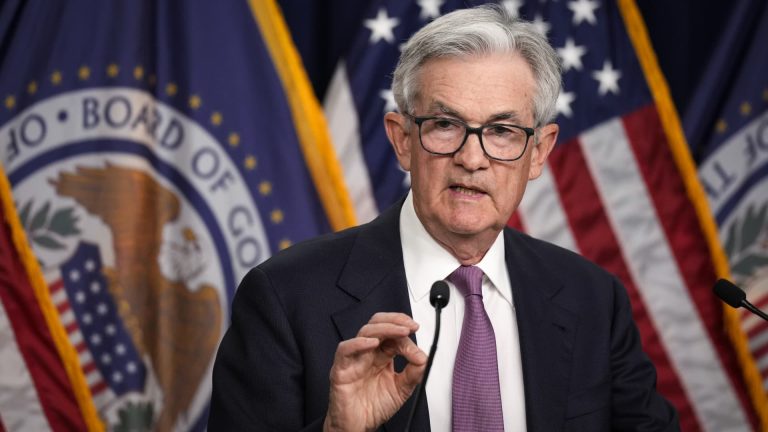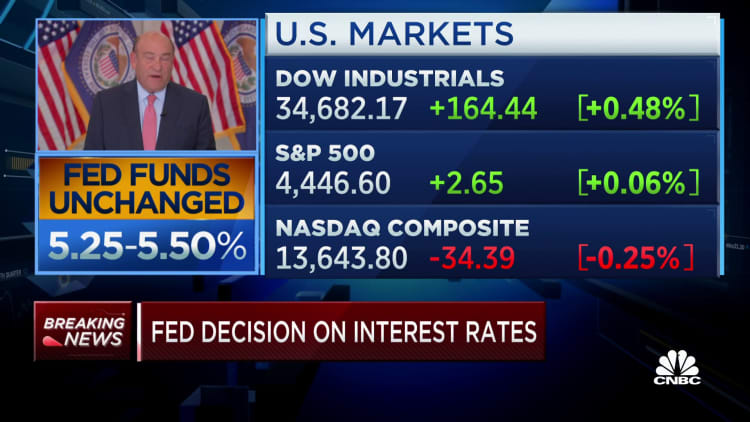
[ad_1]

The Federal Reserve held interest rates steady in a decision released Wednesday, while also indicating it still expects one more hike before the end of the year and fewer cuts than previously indicated next year.
That final increase, if realized, would do it for this cycle, according to projections the central bank released at the end of its two-day meeting. If the Fed goes ahead with the move, it would make a full dozen hikes since the policy tightening began in March 2022.
Markets had fully priced in no move at this meeting, which kept the fed funds rate in a targeted range between 5.25%-5%, the highest in some 22 years. The rate fixes what banks charge each other for overnight lending but also spills over into many forms of consumer debt.
While the no-hike was expected, there was considerable uncertainty over where the rate-setting Federal Open Market Committee would go from here. Judging from documents released Wednesday, the bias appears towards more restrictive policy and a higher-for-longer approach to interest rates.
Projections released in the Fed’s dot-plot showed the likelihood of one more increase this year, then two cuts in 2024, two fewer than were indicated during the last update in June. That would put the funds rate around 5.1%. The plot allows members to indicate anonymously where they think rates are headed.
Twelve participants at the meeting penciled in the additional hike, while seven opposed it. That put one more in opposition than at the June meeting. Recently confirmed Fed Governor Adriana Kugler was not a voter at the last meeting. The projection for the fed funds rate also moved higher for 2025, with the median outlook at 3.9%, compared with 3.4% previously.
Over the longer term, FOMC members again pointed to a funds rate of 2.9% in 2026. That’s above what the Fed considers the “neutral” rate of interest that is neither stimulative nor restrictive for growth. This was the first time the committee provided a look at 2026. The long-run expected neutral rate held at 2.5%.
Along with the rate projections, members also sharply revised up their economic growth expectations for this year, with gross domestic product now expected to increase by 2.1% this year. That was more than double the June estimate and indicative that members do not anticipate a recession anytime soon. The 2024 GDP outlook moved up to 1.5%, from 1.1%.
The expected inflation rate, as measured by the core personal consumption expenditures price index, also moved lower to 3.7%, down 0.2 percentage points from June, as did the outlook for unemployment, now projected at 3.8%, compared to 4.1% previously.
There were a few changes in the post-meeting statement that reflected the adjustment in economic outlook.
The committee characterized economic activity as “expanding at a solid pace,” compared to “moderate” in previous statements. It also noted that job gains “have slowed in recent months but remain strong.” That contrasts with earlier language describing the employment picture as “robust.”
In addition to holding rates at relatively high levels, the Fed is continuing to reduce its bond holdings, a process that has cut the central bank balance sheet by some $815 billion since June 2022. The Fed is allowing up to $95 billion in proceeds from maturing bonds to roll off each month, rather than reinvesting them.
The Fed’s machinations come at a delicate time for the U.S. economy.
In recent public appearances, Fed officials have indicated a shift in thinking, from believing that it was better to do too much to bring down inflation to a new view that is more balanced. That’s partly due to perceived lagged impacts from the rate hikes, which represented the toughest Fed monetary policy since the early 1980s.
There are growing signs that the central bank may yet achieve its soft landing of bringing down inflation without tipping the economy into a deep recession. However, the future remains far from certain, and Fed officials have expressed caution about declaring victory too soon.
The jobs picture has been solid, with an unemployment of 3.8% just slightly higher than it was a year ago. Job openings have been coming down, helping the Fed mark progress against a supply-demand mismatch that at one point had seen two positions for every available worker.
Inflation data also has gotten better, though the annual rate remains well above the Fed’s 2% target. The central bank’s favored gauge in July showed core inflation, which excludes volatile food and energy prices, running at a 4.2% rate.
Consumers, who make up about two-thirds of all economic activity, have been resilient, spending even as savings have diminished and credit card debt has passed the $1 trillion mark for the first time. In a recent University of Michigan survey, respective outlooks for one- and five-year inflation rates hit multi-year lows.
Still, public opinion surveys reflect anxiety over the current state of the economy. In the most recent CNBC All-American Survey, 69% of respondents expressed dissatisfaction with the U.S. economy, a record high in results that go back 17 years.
This is breaking news. Please check back here for updates.
[ad_2]
Source link